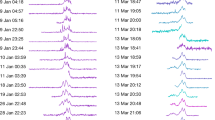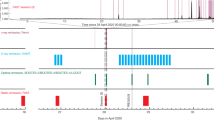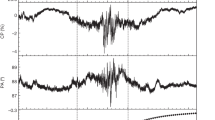Abstract
Sub-second time structures have been found in millimetre waves1,2 and, independently, in hard X rays3,4 emitted during solar bursts. However, because simultaneous observations of such fast time structures in millimetre radio and X-ray ranges had not been available, we planned coordinated observations of the solar burst in November 1981 with a high time resolution of a few milliseconds. The hard X rays (30–40 keV) were observed by the hard X-ray monitor, HXM5, aboard the Hinotori Satellite with a time resolution of 7.81 ms and the radio emissions were observed on the ground by the 45-ft dish at Itapetinga Radio Observatory with a high time resolution (1 ms) and high sensitivities at 22 GHz and 44 GHz (ref. 6), supplemented by patrol observations at 7 GHz with a time resolution of 100 ms. Absolute timing at Itapetinga and Hinotori is better than 10 ms. Correlated sub-second time structures at hard X-ray and at millimetre wavelengths were found for the first time.
This is a preview of subscription content, access via your institution
Access options
Subscribe to this journal
Receive 51 print issues and online access
$199.00 per year
only $3.90 per issue
Buy this article
- Purchase on Springer Link
- Instant access to full article PDF
Prices may be subject to local taxes which are calculated during checkout
Similar content being viewed by others
References
Kaufmann, P., Strauss, F. M., Opher, R. & Laporte, C. Astr. Astrophys. 87, 58–62 (1980).
Hurford, G. J., Marsh, K. A., Zirin, H., Kaufmann, P. & Strauss, F. M. Abstr. Bull. Am. astr. Soc. 11, 678 (1979).
Orwig, L. E., Frost, K. J. & Dennis, B. R. Astrophys. J. Lett. 244, L163–L166 (1981).
Charikov, Y. E., Kocharov, G. E. & Lazutkov, V. P. 17th int. Cosmic Ray Conf. Paris (1981).
Ohki, K. et al. Proc. Hinotori Symp. on Solar Flares 69–88 (ISAS, 1982).
Kaufmann, P., Strauss, F. M., Schaal, R. E. & Laporte, C. Salar Phys. 78, 389–399 (1982).
Bevington, P. R. Data Reduction and Error Analysis for the Physical Sciences (McGraw-Hill, New York, 1969).
Makishima, K. Proc. Hinotori Symp. on Solar Flares 120–129 (ISAS, 1982).
Takakura, T. et al. Astrophys. J. (submitted).
Takakura, T., Ohki, K., Tsuneta, S. & Nitta, N. Proc. of Japan–US Seminar on Recent Advances in the Understanding of Solar Flares (1982).
Brown, J. C., Craig, J. D. & Karpen, J. T. Solar Phys. 67, 143–162 (1980).
Sturrock, P. A., Kaufmann, P. & Smith, D. F. Energy Release in Solar Flares (Stanford University Institute of Plasma Research, Rep. SUIPR No. 933 1982).
Spicer, D. S. Solar. Phys. 70, 149–172 (1981)
Zaitsev, V. V. & Stepanov, A. V. Solar Phys. (submitted).
Author information
Authors and Affiliations
Rights and permissions
About this article
Cite this article
Takakura, T., Kaufmann, P., Costa, J. et al. Sub-second pulsations simultaneously observed at microwaves and hard X rays in a solar burst. Nature 302, 317–319 (1983). https://doi.org/10.1038/302317a0
Received:
Accepted:
Issue Date:
DOI: https://doi.org/10.1038/302317a0
This article is cited by
-
Quasi-Periodic Pulsations in Solar and Stellar Flares: A Review of Underpinning Physical Mechanisms and Their Predicted Observational Signatures
Space Science Reviews (2021)
-
Turbulent spectrum of Alfvén waves excited by a kinetic instability for explaining the modulations with multi-timescales in solar flares
Astrophysics and Space Science (2009)
-
Simultaneous observations of second and sub-second time structures in H α , radio and hard X-ray data due to the periodical particle acceleration and MHD waves in the November 1, 2004 flare
Astrophysics and Space Science (2007)
-
MHD surface waves in a complex (longitudinal + sheared) magnetic field
Solar Physics (1996)
-
Dissipating the energy of magnetoacoustic waves in a structured atmosphere
Solar Physics (1995)
Comments
By submitting a comment you agree to abide by our Terms and Community Guidelines. If you find something abusive or that does not comply with our terms or guidelines please flag it as inappropriate.



